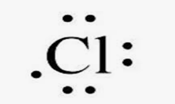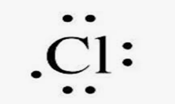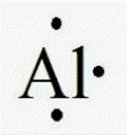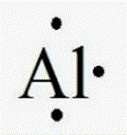
(a)
Interpretation: To write the electron dot structure of the chlorine atom.
Concept Introduction: Electron dot structure is the presentation of electrons that are occupied in the outermost shell of the atom.
(a)
Answer to Problem 29A
The electron dot structure of the chlorine atom can be shown as:

Explanation of Solution
The

(b)
Interpretation: To write the electron dot structure of the Sulphur atom.
Concept Introduction: Electron dot structure is the presentation of electrons that are occupied in the outermost shell of the atom.
(b)
Answer to Problem 29A
The electron dot structure of the sulfur atom can be shown as:

Explanation of Solution
The atomic number of sulfur atoms is 16. The electronic configuration of chlorine is 2,8,6. It can be seen that chlorine has six valence electrons. In the electron dot structure, valence electrons are shown by the dot surrounding the atom. The electron dot structure of sulfur is shown below:

(c)
Interpretation: To determine the electron dot structure of the aluminum atom.
Concept Introduction: Electron dot structure is the presentation of electrons that are occupied in the outermost shell of the atom.
(c)
Answer to Problem 29A
The electron dot structure of the aluminum atom can be shown as:

Explanation of Solution
The atomic number of the aluminum atom is 13. The electronic configuration of chlorine is 2,8,3. It can be seen that chlorine has three valence electrons. In the electron dot structure, valence electrons are shown by the dot surrounding the atom. The electron dot structure of sulfur is shown below:

(d)
Interpretation: To determine the electron dot structure of the lithium atom.
Concept Introduction: Electron dot structure is the presentation of electrons that are occupied in the outermost shell of the atom.
(d)
Answer to Problem 29A
The electron dot structure of the lithium atom can be shown as:

Explanation of Solution
The atomic number of the Lithium atom is 3. The electronic configuration of chlorine is 2,1. Chlorine has one valence of electrons. In the electron dot structure, valence electrons are shown by the dot surrounding the atom. The electron dot structure of lithium is shown below:

Chapter 7 Solutions
Chemistry 2012 Student Edition (hard Cover) Grade 11
 ChemistryChemistryISBN:9781305957404Author:Steven S. Zumdahl, Susan A. Zumdahl, Donald J. DeCostePublisher:Cengage Learning
ChemistryChemistryISBN:9781305957404Author:Steven S. Zumdahl, Susan A. Zumdahl, Donald J. DeCostePublisher:Cengage Learning ChemistryChemistryISBN:9781259911156Author:Raymond Chang Dr., Jason Overby ProfessorPublisher:McGraw-Hill Education
ChemistryChemistryISBN:9781259911156Author:Raymond Chang Dr., Jason Overby ProfessorPublisher:McGraw-Hill Education Principles of Instrumental AnalysisChemistryISBN:9781305577213Author:Douglas A. Skoog, F. James Holler, Stanley R. CrouchPublisher:Cengage Learning
Principles of Instrumental AnalysisChemistryISBN:9781305577213Author:Douglas A. Skoog, F. James Holler, Stanley R. CrouchPublisher:Cengage Learning Organic ChemistryChemistryISBN:9780078021558Author:Janice Gorzynski Smith Dr.Publisher:McGraw-Hill Education
Organic ChemistryChemistryISBN:9780078021558Author:Janice Gorzynski Smith Dr.Publisher:McGraw-Hill Education Chemistry: Principles and ReactionsChemistryISBN:9781305079373Author:William L. Masterton, Cecile N. HurleyPublisher:Cengage Learning
Chemistry: Principles and ReactionsChemistryISBN:9781305079373Author:William L. Masterton, Cecile N. HurleyPublisher:Cengage Learning Elementary Principles of Chemical Processes, Bind...ChemistryISBN:9781118431221Author:Richard M. Felder, Ronald W. Rousseau, Lisa G. BullardPublisher:WILEY
Elementary Principles of Chemical Processes, Bind...ChemistryISBN:9781118431221Author:Richard M. Felder, Ronald W. Rousseau, Lisa G. BullardPublisher:WILEY





